check oil BMW X3 2014 F25 Owner's Manual
[x] Cancel search | Manufacturer: BMW, Model Year: 2014, Model line: X3, Model: BMW X3 2014 F25Pages: 251, PDF Size: 5.79 MB
Page 83 of 251
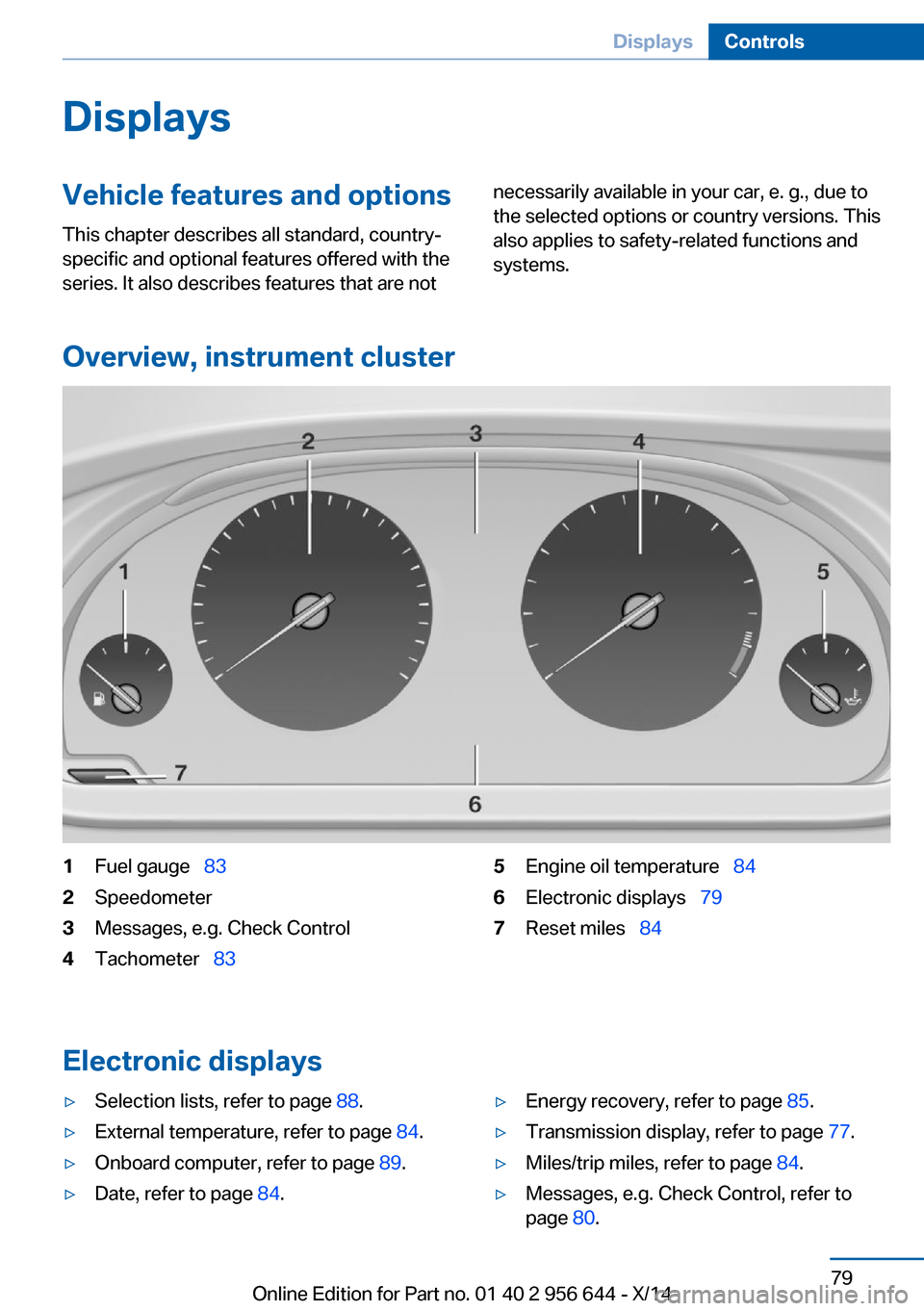
DisplaysVehicle features and optionsThis chapter describes all standard, country-
specific and optional features offered with the
series. It also describes features that are notnecessarily available in your car, e. g., due to
the selected options or country versions. This
also applies to safety-related functions and
systems.
Overview, instrument cluster
1Fuel gauge 832Speedometer3Messages, e.g. Check Control4Tachometer 835Engine oil temperature 846Electronic displays 797Reset miles 84
Electronic displays
▷Selection lists, refer to page 88.▷External temperature, refer to page 84.▷Onboard computer, refer to page 89.▷Date, refer to page 84.▷Energy recovery, refer to page 85.▷Transmission display, refer to page 77.▷Miles/trip miles, refer to page 84.▷Messages, e.g. Check Control, refer to
page 80.Seite 79DisplaysControls79
Online Edition for Part no. 01 40 2 956 644 - X/14
Page 88 of 251
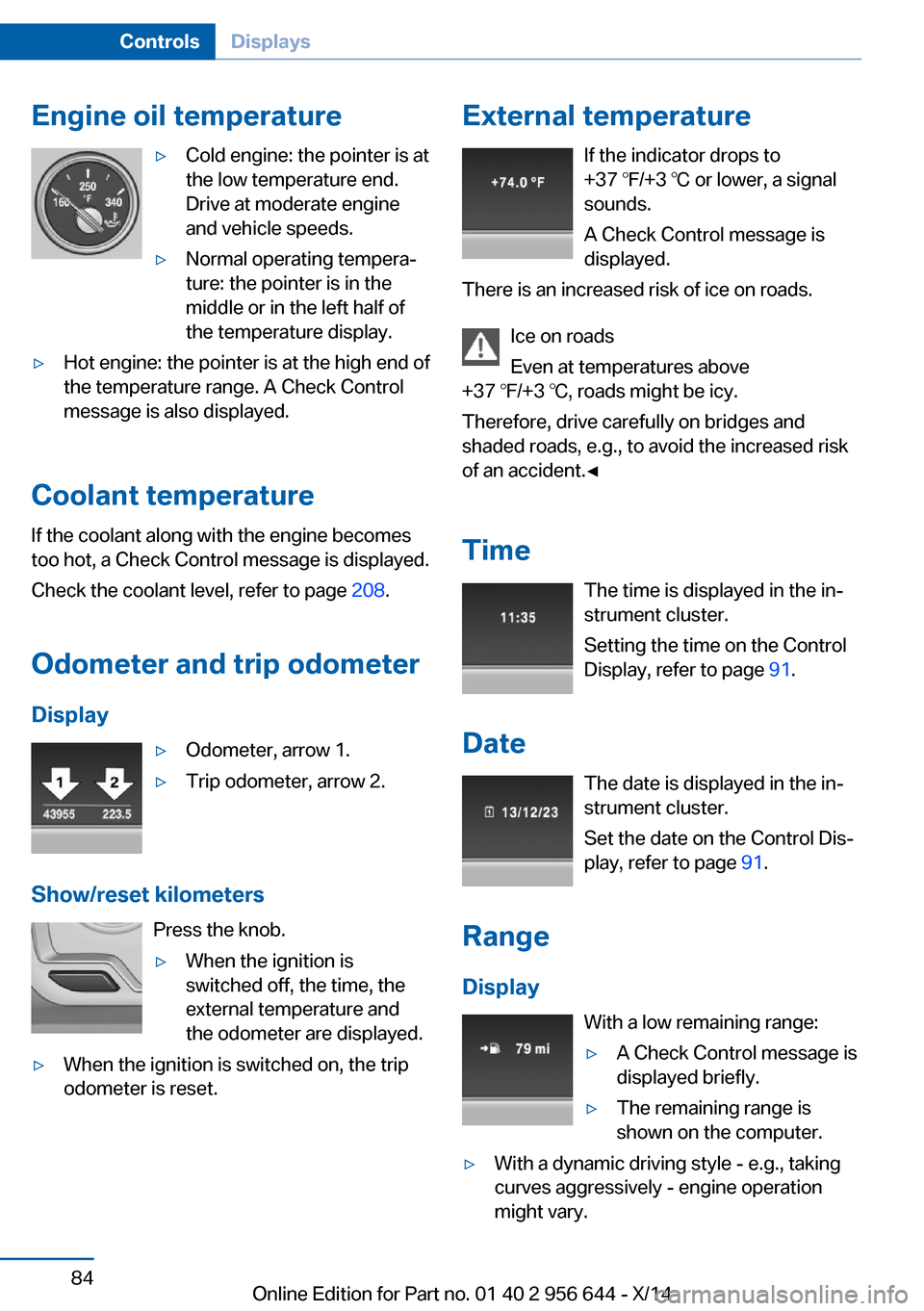
Engine oil temperature▷Cold engine: the pointer is at
the low temperature end.
Drive at moderate engine
and vehicle speeds.▷Normal operating tempera‐
ture: the pointer is in the
middle or in the left half of
the temperature display.▷Hot engine: the pointer is at the high end of
the temperature range. A Check Control
message is also displayed.
Coolant temperature
If the coolant along with the engine becomes
too hot, a Check Control message is displayed.
Check the coolant level, refer to page 208.
Odometer and trip odometer Display
▷Odometer, arrow 1.▷Trip odometer, arrow 2.
Show/reset kilometers Press the knob.
▷When the ignition is
switched off, the time, the
external temperature and
the odometer are displayed.▷When the ignition is switched on, the trip
odometer is reset.External temperature
If the indicator drops to
+37 ℉/+3 ℃ or lower, a signal
sounds.
A Check Control message is displayed.
There is an increased risk of ice on roads.
Ice on roads
Even at temperatures above
+37 ℉/+3 ℃, roads might be icy.
Therefore, drive carefully on bridges and
shaded roads, e.g., to avoid the increased risk
of an accident.◀
Time The time is displayed in the in‐
strument cluster.
Setting the time on the Control
Display, refer to page 91.
Date The date is displayed in the in‐
strument cluster.
Set the date on the Control Dis‐
play, refer to page 91.
Range Display With a low remaining range:▷A Check Control message is
displayed briefly.▷The remaining range is
shown on the computer.▷With a dynamic driving style - e.g., taking
curves aggressively - engine operation
might vary.Seite 84ControlsDisplays84
Online Edition for Part no. 01 40 2 956 644 - X/14
Page 177 of 251
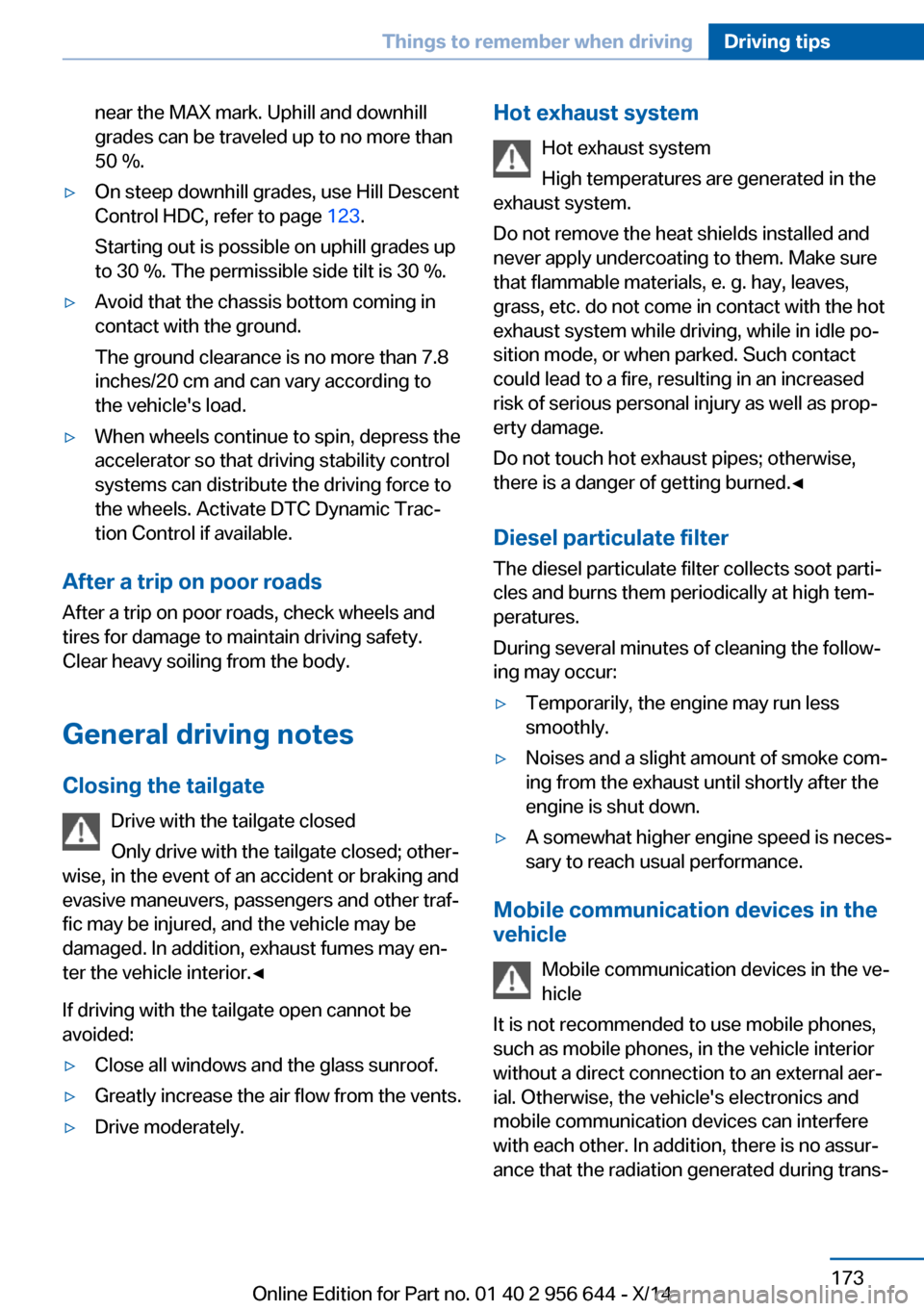
near the MAX mark. Uphill and downhill
grades can be traveled up to no more than
50 %.▷On steep downhill grades, use Hill Descent
Control HDC, refer to page 123.
Starting out is possible on uphill grades up
to 30 %. The permissible side tilt is 30 %.▷Avoid that the chassis bottom coming in
contact with the ground.
The ground clearance is no more than 7.8
inches/20 cm and can vary according to
the vehicle's load.▷When wheels continue to spin, depress the
accelerator so that driving stability control
systems can distribute the driving force to
the wheels. Activate DTC Dynamic Trac‐
tion Control if available.
After a trip on poor roads
After a trip on poor roads, check wheels and
tires for damage to maintain driving safety.
Clear heavy soiling from the body.
General driving notes
Closing the tailgate Drive with the tailgate closed
Only drive with the tailgate closed; other‐
wise, in the event of an accident or braking and
evasive maneuvers, passengers and other traf‐
fic may be injured, and the vehicle may be
damaged. In addition, exhaust fumes may en‐
ter the vehicle interior.◀
If driving with the tailgate open cannot be
avoided:
▷Close all windows and the glass sunroof.▷Greatly increase the air flow from the vents.▷Drive moderately.Hot exhaust system
Hot exhaust system
High temperatures are generated in the
exhaust system.
Do not remove the heat shields installed and
never apply undercoating to them. Make sure
that flammable materials, e. g. hay, leaves,
grass, etc. do not come in contact with the hot
exhaust system while driving, while in idle po‐
sition mode, or when parked. Such contact
could lead to a fire, resulting in an increased
risk of serious personal injury as well as prop‐
erty damage.
Do not touch hot exhaust pipes; otherwise,
there is a danger of getting burned.◀
Diesel particulate filter The diesel particulate filter collects soot parti‐
cles and burns them periodically at high tem‐
peratures.
During several minutes of cleaning the follow‐
ing may occur:▷Temporarily, the engine may run less
smoothly.▷Noises and a slight amount of smoke com‐
ing from the exhaust until shortly after the
engine is shut down.▷A somewhat higher engine speed is neces‐
sary to reach usual performance.
Mobile communication devices in the
vehicle
Mobile communication devices in the ve‐
hicle
It is not recommended to use mobile phones,
such as mobile phones, in the vehicle interior
without a direct connection to an external aer‐
ial. Otherwise, the vehicle's electronics and
mobile communication devices can interfere
with each other. In addition, there is no assur‐
ance that the radiation generated during trans‐
Seite 173Things to remember when drivingDriving tips173
Online Edition for Part no. 01 40 2 956 644 - X/14
Page 209 of 251
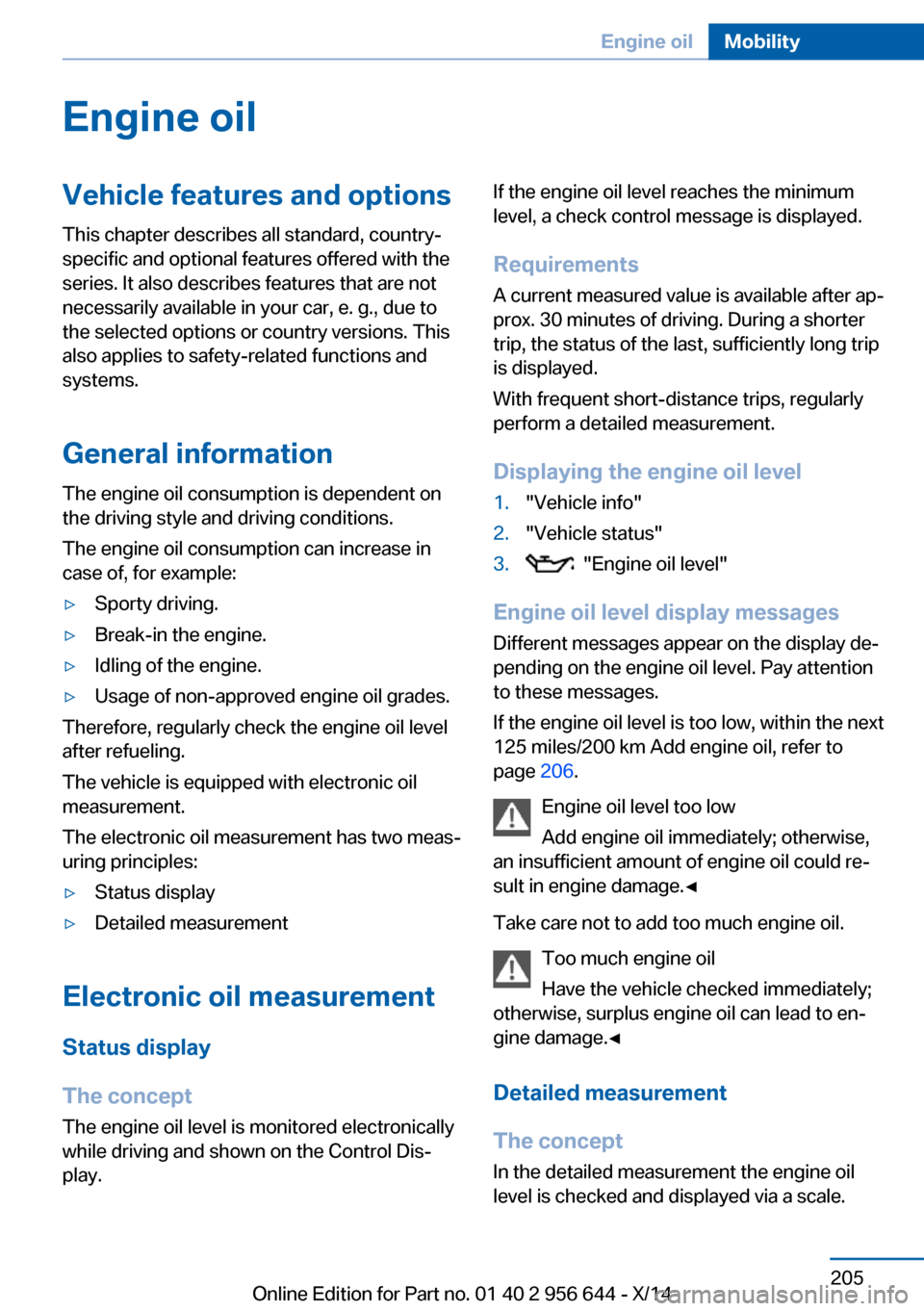
Engine oilVehicle features and options
This chapter describes all standard, country-
specific and optional features offered with the
series. It also describes features that are not
necessarily available in your car, e. g., due to
the selected options or country versions. This
also applies to safety-related functions and
systems.
General information
The engine oil consumption is dependent on
the driving style and driving conditions.
The engine oil consumption can increase in
case of, for example:▷Sporty driving.▷Break-in the engine.▷Idling of the engine.▷Usage of non-approved engine oil grades.
Therefore, regularly check the engine oil level
after refueling.
The vehicle is equipped with electronic oil
measurement.
The electronic oil measurement has two meas‐
uring principles:
▷Status display▷Detailed measurement
Electronic oil measurement
Status display
The concept
The engine oil level is monitored electronically
while driving and shown on the Control Dis‐
play.
If the engine oil level reaches the minimum
level, a check control message is displayed.
Requirements
A current measured value is available after ap‐
prox. 30 minutes of driving. During a shorter
trip, the status of the last, sufficiently long trip
is displayed.
With frequent short-distance trips, regularly
perform a detailed measurement.
Displaying the engine oil level1."Vehicle info"2."Vehicle status"3. "Engine oil level"
Engine oil level display messages
Different messages appear on the display de‐
pending on the engine oil level. Pay attention
to these messages.
If the engine oil level is too low, within the next
125 miles/200 km Add engine oil, refer to
page 206.
Engine oil level too low
Add engine oil immediately; otherwise,
an insufficient amount of engine oil could re‐
sult in engine damage.◀
Take care not to add too much engine oil. Too much engine oil
Have the vehicle checked immediately;
otherwise, surplus engine oil can lead to en‐
gine damage.◀
Detailed measurement
The concept In the detailed measurement the engine oil
level is checked and displayed via a scale.
Seite 205Engine oilMobility205
Online Edition for Part no. 01 40 2 956 644 - X/14
Page 210 of 251
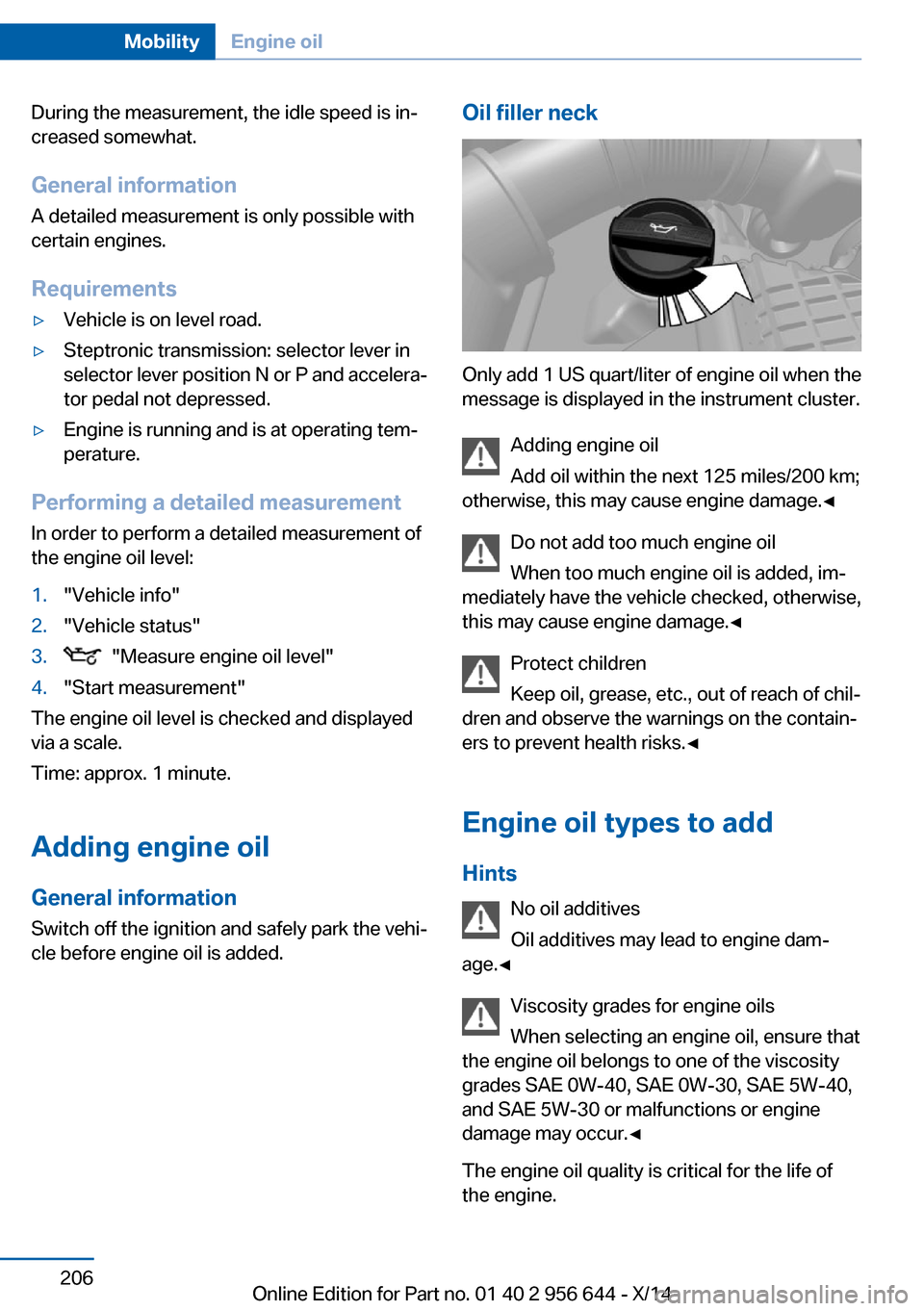
During the measurement, the idle speed is in‐
creased somewhat.
General information A detailed measurement is only possible with
certain engines.
Requirements▷Vehicle is on level road.▷Steptronic transmission: selector lever in
selector lever position N or P and accelera‐
tor pedal not depressed.▷Engine is running and is at operating tem‐
perature.
Performing a detailed measurement
In order to perform a detailed measurement of
the engine oil level:
1."Vehicle info"2."Vehicle status"3. "Measure engine oil level"4."Start measurement"
The engine oil level is checked and displayed
via a scale.
Time: approx. 1 minute.
Adding engine oil General information
Switch off the ignition and safely park the vehi‐
cle before engine oil is added.
Oil filler neck
Only add 1 US quart/liter of engine oil when the
message is displayed in the instrument cluster.
Adding engine oil
Add oil within the next 125 miles/200 km;
otherwise, this may cause engine damage.◀
Do not add too much engine oil
When too much engine oil is added, im‐
mediately have the vehicle checked, otherwise,
this may cause engine damage.◀
Protect children
Keep oil, grease, etc., out of reach of chil‐
dren and observe the warnings on the contain‐
ers to prevent health risks.◀
Engine oil types to add Hints No oil additives
Oil additives may lead to engine dam‐
age.◀
Viscosity grades for engine oils
When selecting an engine oil, ensure that
the engine oil belongs to one of the viscosity
grades SAE 0W-40, SAE 0W-30, SAE 5W-40,
and SAE 5W-30 or malfunctions or engine
damage may occur.◀
The engine oil quality is critical for the life of
the engine.
Seite 206MobilityEngine oil206
Online Edition for Part no. 01 40 2 956 644 - X/14
Page 214 of 251
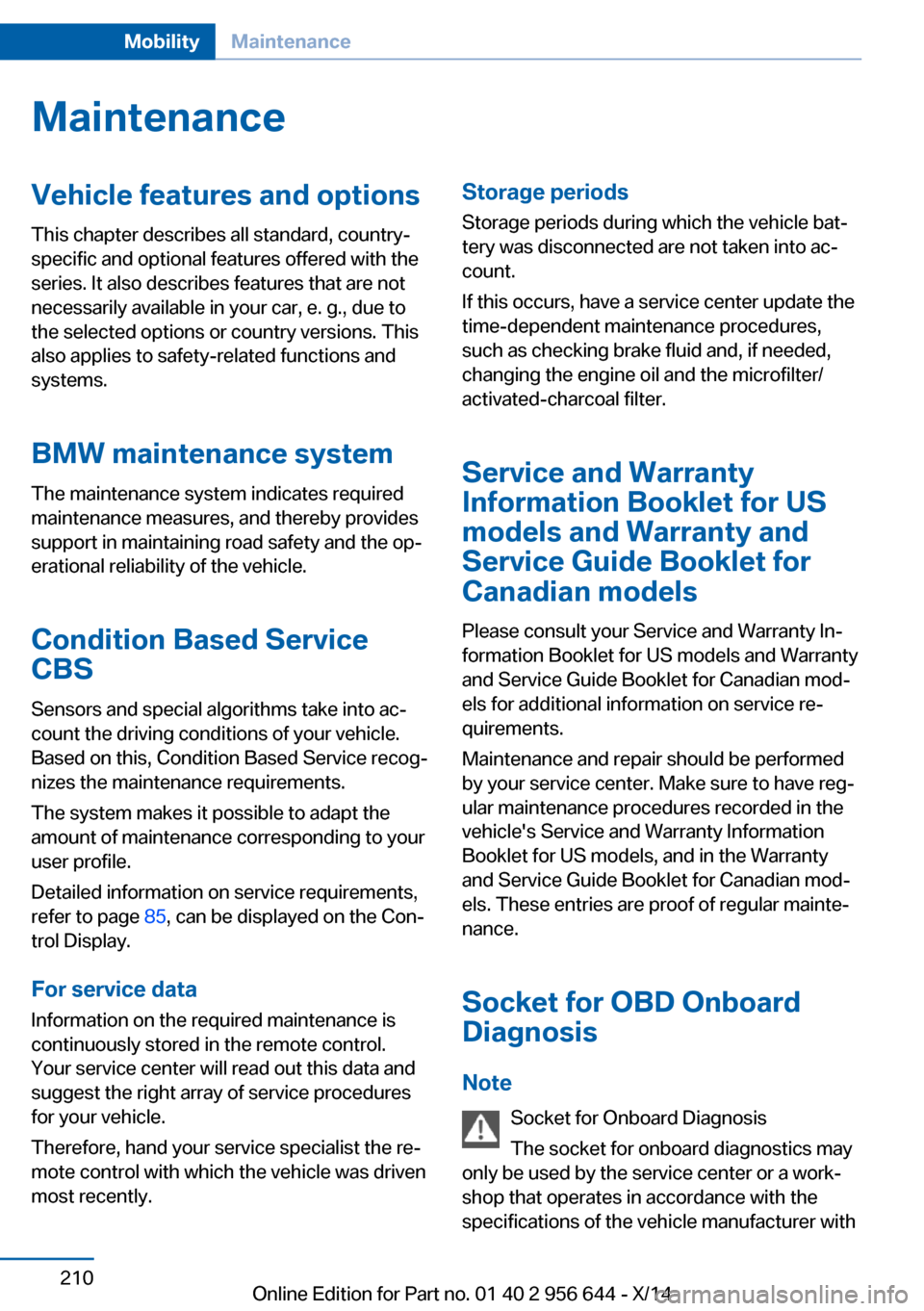
MaintenanceVehicle features and options
This chapter describes all standard, country-
specific and optional features offered with the
series. It also describes features that are not
necessarily available in your car, e. g., due to
the selected options or country versions. This
also applies to safety-related functions and
systems.
BMW maintenance system
The maintenance system indicates required
maintenance measures, and thereby provides
support in maintaining road safety and the op‐
erational reliability of the vehicle.
Condition Based Service
CBS
Sensors and special algorithms take into ac‐
count the driving conditions of your vehicle.
Based on this, Condition Based Service recog‐
nizes the maintenance requirements.
The system makes it possible to adapt the
amount of maintenance corresponding to your
user profile.
Detailed information on service requirements,
refer to page 85, can be displayed on the Con‐
trol Display.
For service data
Information on the required maintenance is
continuously stored in the remote control. Your service center will read out this data and
suggest the right array of service procedures for your vehicle.
Therefore, hand your service specialist the re‐
mote control with which the vehicle was driven
most recently.Storage periods
Storage periods during which the vehicle bat‐
tery was disconnected are not taken into ac‐
count.
If this occurs, have a service center update the
time-dependent maintenance procedures,
such as checking brake fluid and, if needed,
changing the engine oil and the microfilter/
activated-charcoal filter.
Service and Warranty
Information Booklet for US
models and Warranty and
Service Guide Booklet for
Canadian models
Please consult your Service and Warranty In‐
formation Booklet for US models and Warranty
and Service Guide Booklet for Canadian mod‐ els for additional information on service re‐
quirements.
Maintenance and repair should be performed
by your service center. Make sure to have reg‐
ular maintenance procedures recorded in the
vehicle's Service and Warranty Information
Booklet for US models, and in the Warranty
and Service Guide Booklet for Canadian mod‐
els. These entries are proof of regular mainte‐
nance.
Socket for OBD Onboard
Diagnosis
Note Socket for Onboard Diagnosis
The socket for onboard diagnostics may
only be used by the service center or a work‐
shop that operates in accordance with the
specifications of the vehicle manufacturer withSeite 210MobilityMaintenance210
Online Edition for Part no. 01 40 2 956 644 - X/14
Page 231 of 251
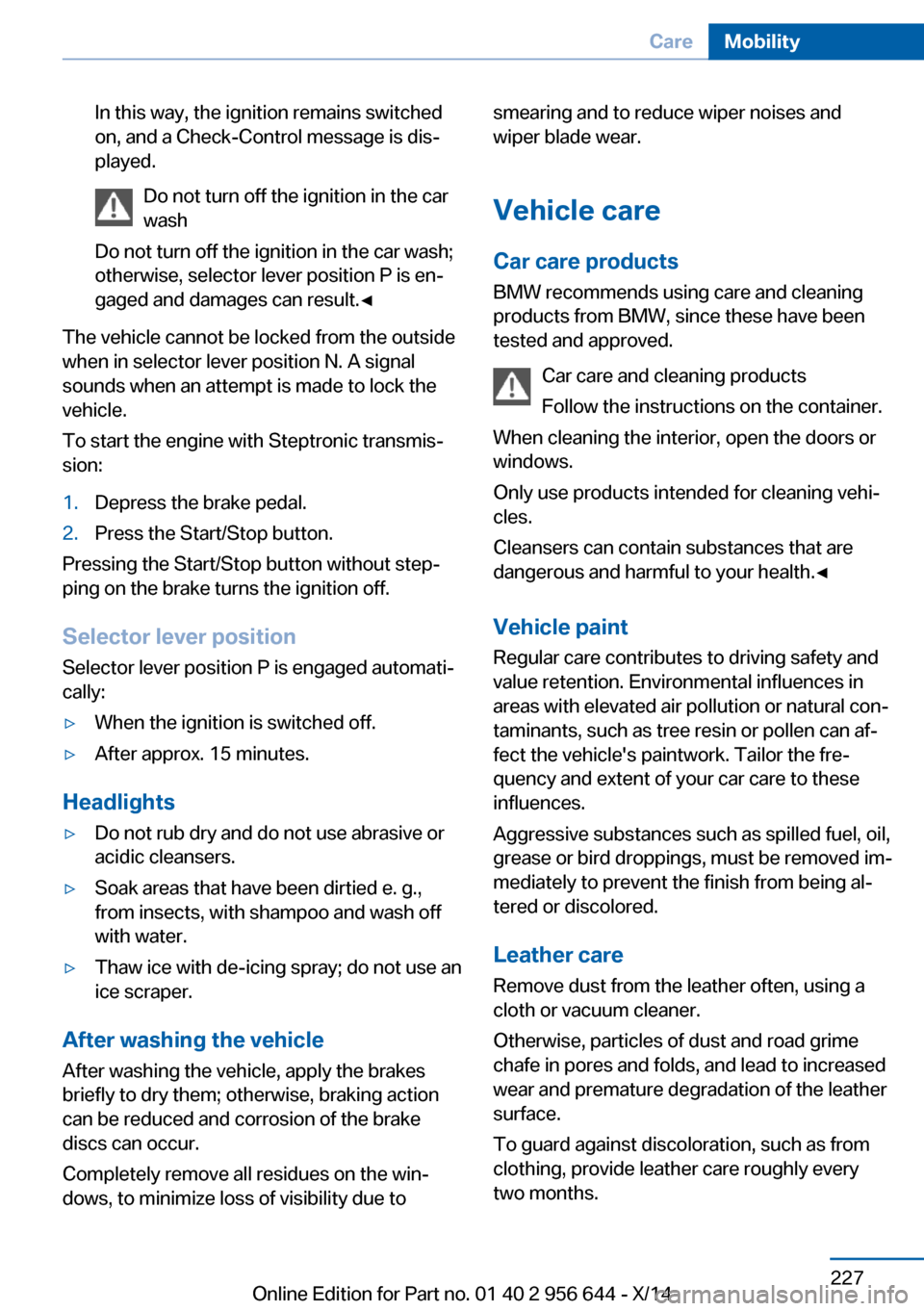
In this way, the ignition remains switched
on, and a Check-Control message is dis‐
played.
Do not turn off the ignition in the car
wash
Do not turn off the ignition in the car wash;
otherwise, selector lever position P is en‐
gaged and damages can result.◀
The vehicle cannot be locked from the outside
when in selector lever position N. A signal
sounds when an attempt is made to lock the
vehicle.
To start the engine with Steptronic transmis‐
sion:
1.Depress the brake pedal.2.Press the Start/Stop button.
Pressing the Start/Stop button without step‐
ping on the brake turns the ignition off.
Selector lever positionSelector lever position P is engaged automati‐
cally:
▷When the ignition is switched off.▷After approx. 15 minutes.
Headlights
▷Do not rub dry and do not use abrasive or
acidic cleansers.▷Soak areas that have been dirtied e. g.,
from insects, with shampoo and wash off
with water.▷Thaw ice with de-icing spray; do not use an
ice scraper.
After washing the vehicle
After washing the vehicle, apply the brakes
briefly to dry them; otherwise, braking action
can be reduced and corrosion of the brake
discs can occur.
Completely remove all residues on the win‐
dows, to minimize loss of visibility due to
smearing and to reduce wiper noises and
wiper blade wear.
Vehicle care
Car care products BMW recommends using care and cleaning
products from BMW, since these have been
tested and approved.
Car care and cleaning products
Follow the instructions on the container.
When cleaning the interior, open the doors or
windows.
Only use products intended for cleaning vehi‐
cles.
Cleansers can contain substances that are
dangerous and harmful to your health.◀
Vehicle paint
Regular care contributes to driving safety and
value retention. Environmental influences in
areas with elevated air pollution or natural con‐
taminants, such as tree resin or pollen can af‐
fect the vehicle's paintwork. Tailor the fre‐
quency and extent of your car care to these
influences.
Aggressive substances such as spilled fuel, oil,
grease or bird droppings, must be removed im‐
mediately to prevent the finish from being al‐
tered or discolored.
Leather care
Remove dust from the leather often, using a
cloth or vacuum cleaner.
Otherwise, particles of dust and road grime
chafe in pores and folds, and lead to increased
wear and premature degradation of the leather
surface.
To guard against discoloration, such as from
clothing, provide leather care roughly every
two months.Seite 227CareMobility227
Online Edition for Part no. 01 40 2 956 644 - X/14
Page 241 of 251
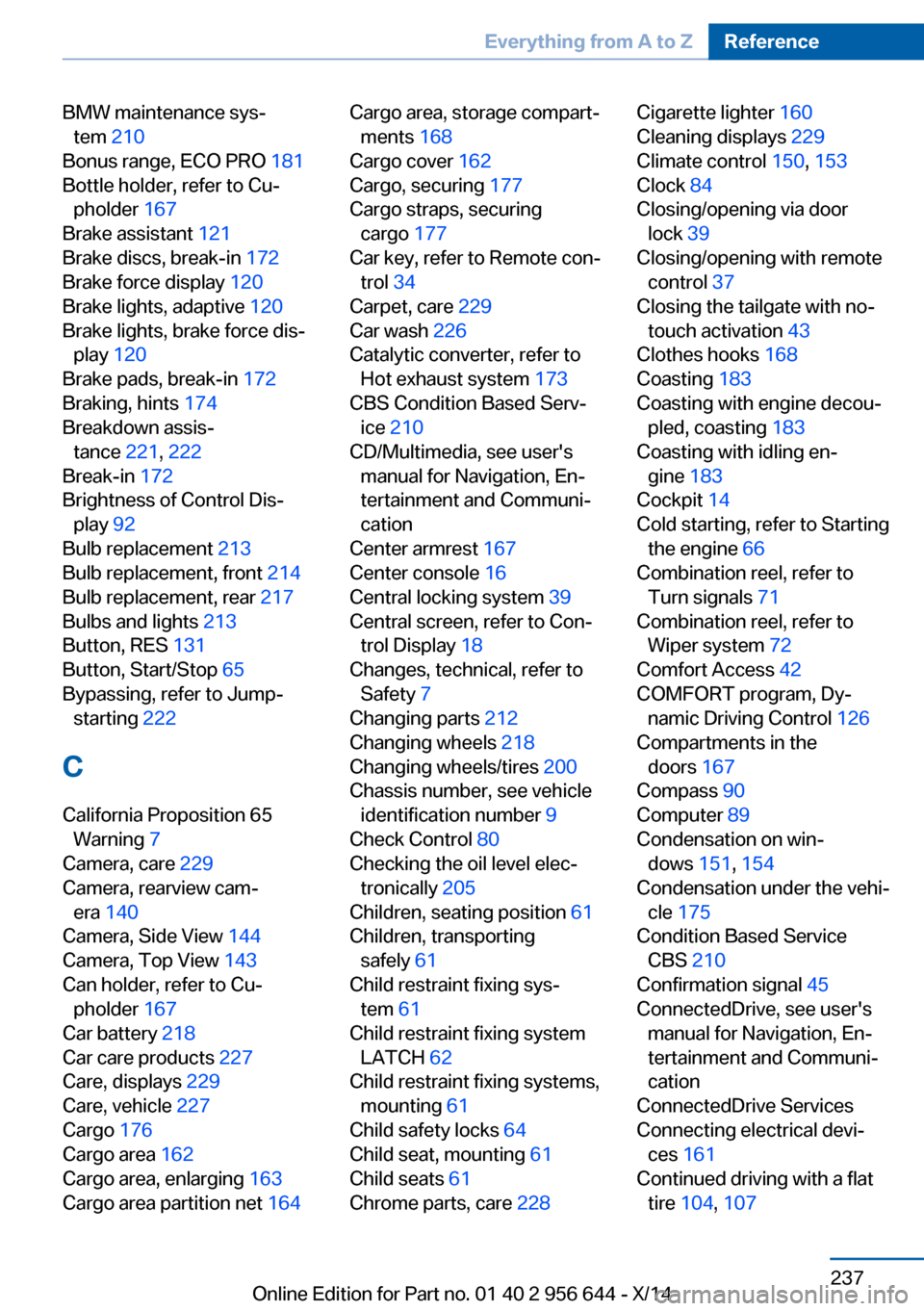
BMW maintenance sys‐tem 210
Bonus range, ECO PRO 181
Bottle holder, refer to Cu‐ pholder 167
Brake assistant 121
Brake discs, break-in 172
Brake force display 120
Brake lights, adaptive 120
Brake lights, brake force dis‐ play 120
Brake pads, break-in 172
Braking, hints 174
Breakdown assis‐ tance 221, 222
Break-in 172
Brightness of Control Dis‐ play 92
Bulb replacement 213
Bulb replacement, front 214
Bulb replacement, rear 217
Bulbs and lights 213
Button, RES 131
Button, Start/Stop 65
Bypassing, refer to Jump- starting 222
C
California Proposition 65 Warning 7
Camera, care 229
Camera, rearview cam‐ era 140
Camera, Side View 144
Camera, Top View 143
Can holder, refer to Cu‐ pholder 167
Car battery 218
Car care products 227
Care, displays 229
Care, vehicle 227
Cargo 176
Cargo area 162
Cargo area, enlarging 163
Cargo area partition net 164 Cargo area, storage compart‐
ments 168
Cargo cover 162
Cargo, securing 177
Cargo straps, securing cargo 177
Car key, refer to Remote con‐ trol 34
Carpet, care 229
Car wash 226
Catalytic converter, refer to Hot exhaust system 173
CBS Condition Based Serv‐ ice 210
CD/Multimedia, see user's manual for Navigation, En‐
tertainment and Communi‐
cation
Center armrest 167
Center console 16
Central locking system 39
Central screen, refer to Con‐ trol Display 18
Changes, technical, refer to Safety 7
Changing parts 212
Changing wheels 218
Changing wheels/tires 200
Chassis number, see vehicle identification number 9
Check Control 80
Checking the oil level elec‐ tronically 205
Children, seating position 61
Children, transporting safely 61
Child restraint fixing sys‐ tem 61
Child restraint fixing system LATCH 62
Child restraint fixing systems, mounting 61
Child safety locks 64
Child seat, mounting 61
Child seats 61
Chrome parts, care 228 Cigarette lighter 160
Cleaning displays 229
Climate control 150, 153
Clock 84
Closing/opening via door lock 39
Closing/opening with remote control 37
Closing the tailgate with no- touch activation 43
Clothes hooks 168
Coasting 183
Coasting with engine decou‐ pled, coasting 183
Coasting with idling en‐ gine 183
Cockpit 14
Cold starting, refer to Starting the engine 66
Combination reel, refer to Turn signals 71
Combination reel, refer to Wiper system 72
Comfort Access 42
COMFORT program, Dy‐ namic Driving Control 126
Compartments in the doors 167
Compass 90
Computer 89
Condensation on win‐ dows 151, 154
Condensation under the vehi‐ cle 175
Condition Based Service CBS 210
Confirmation signal 45
ConnectedDrive, see user's manual for Navigation, En‐
tertainment and Communi‐
cation
ConnectedDrive Services
Connecting electrical devi‐ ces 161
Continued driving with a flat tire 104 , 107 Seite 237Everything from A to ZReference237
Online Edition for Part no. 01 40 2 956 644 - X/14
Page 243 of 251
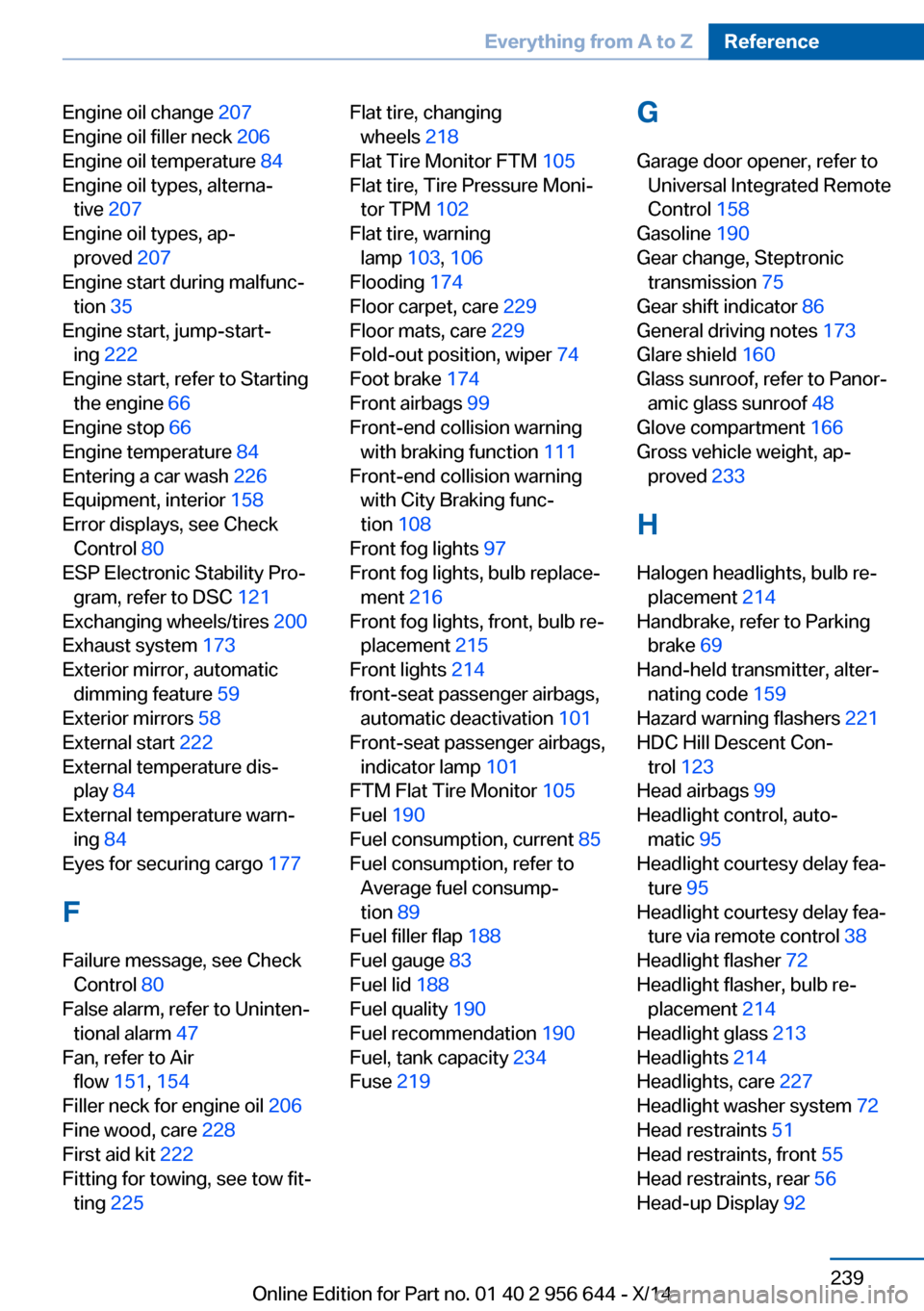
Engine oil change 207
Engine oil filler neck 206
Engine oil temperature 84
Engine oil types, alterna‐ tive 207
Engine oil types, ap‐ proved 207
Engine start during malfunc‐ tion 35
Engine start, jump-start‐ ing 222
Engine start, refer to Starting the engine 66
Engine stop 66
Engine temperature 84
Entering a car wash 226
Equipment, interior 158
Error displays, see Check Control 80
ESP Electronic Stability Pro‐ gram, refer to DSC 121
Exchanging wheels/tires 200
Exhaust system 173
Exterior mirror, automatic dimming feature 59
Exterior mirrors 58
External start 222
External temperature dis‐ play 84
External temperature warn‐ ing 84
Eyes for securing cargo 177
F
Failure message, see Check Control 80
False alarm, refer to Uninten‐ tional alarm 47
Fan, refer to Air flow 151, 154
Filler neck for engine oil 206
Fine wood, care 228
First aid kit 222
Fitting for towing, see tow fit‐ ting 225 Flat tire, changing
wheels 218
Flat Tire Monitor FTM 105
Flat tire, Tire Pressure Moni‐ tor TPM 102
Flat tire, warning lamp 103, 106
Flooding 174
Floor carpet, care 229
Floor mats, care 229
Fold-out position, wiper 74
Foot brake 174
Front airbags 99
Front-end collision warning with braking function 111
Front-end collision warning with City Braking func‐
tion 108
Front fog lights 97
Front fog lights, bulb replace‐ ment 216
Front fog lights, front, bulb re‐ placement 215
Front lights 214
front-seat passenger airbags, automatic deactivation 101
Front-seat passenger airbags, indicator lamp 101
FTM Flat Tire Monitor 105
Fuel 190
Fuel consumption, current 85
Fuel consumption, refer to Average fuel consump‐
tion 89
Fuel filler flap 188
Fuel gauge 83
Fuel lid 188
Fuel quality 190
Fuel recommendation 190
Fuel, tank capacity 234
Fuse 219 G
Garage door opener, refer to Universal Integrated Remote
Control 158
Gasoline 190
Gear change, Steptronic transmission 75
Gear shift indicator 86
General driving notes 173
Glare shield 160
Glass sunroof, refer to Panor‐ amic glass sunroof 48
Glove compartment 166
Gross vehicle weight, ap‐ proved 233
H
Halogen headlights, bulb re‐ placement 214
Handbrake, refer to Parking brake 69
Hand-held transmitter, alter‐ nating code 159
Hazard warning flashers 221
HDC Hill Descent Con‐ trol 123
Head airbags 99
Headlight control, auto‐ matic 95
Headlight courtesy delay fea‐ ture 95
Headlight courtesy delay fea‐ ture via remote control 38
Headlight flasher 72
Headlight flasher, bulb re‐ placement 214
Headlight glass 213
Headlights 214
Headlights, care 227
Headlight washer system 72
Head restraints 51
Head restraints, front 55
Head restraints, rear 56
Head-up Display 92 Seite 239Everything from A to ZReference239
Online Edition for Part no. 01 40 2 956 644 - X/14
Page 245 of 251
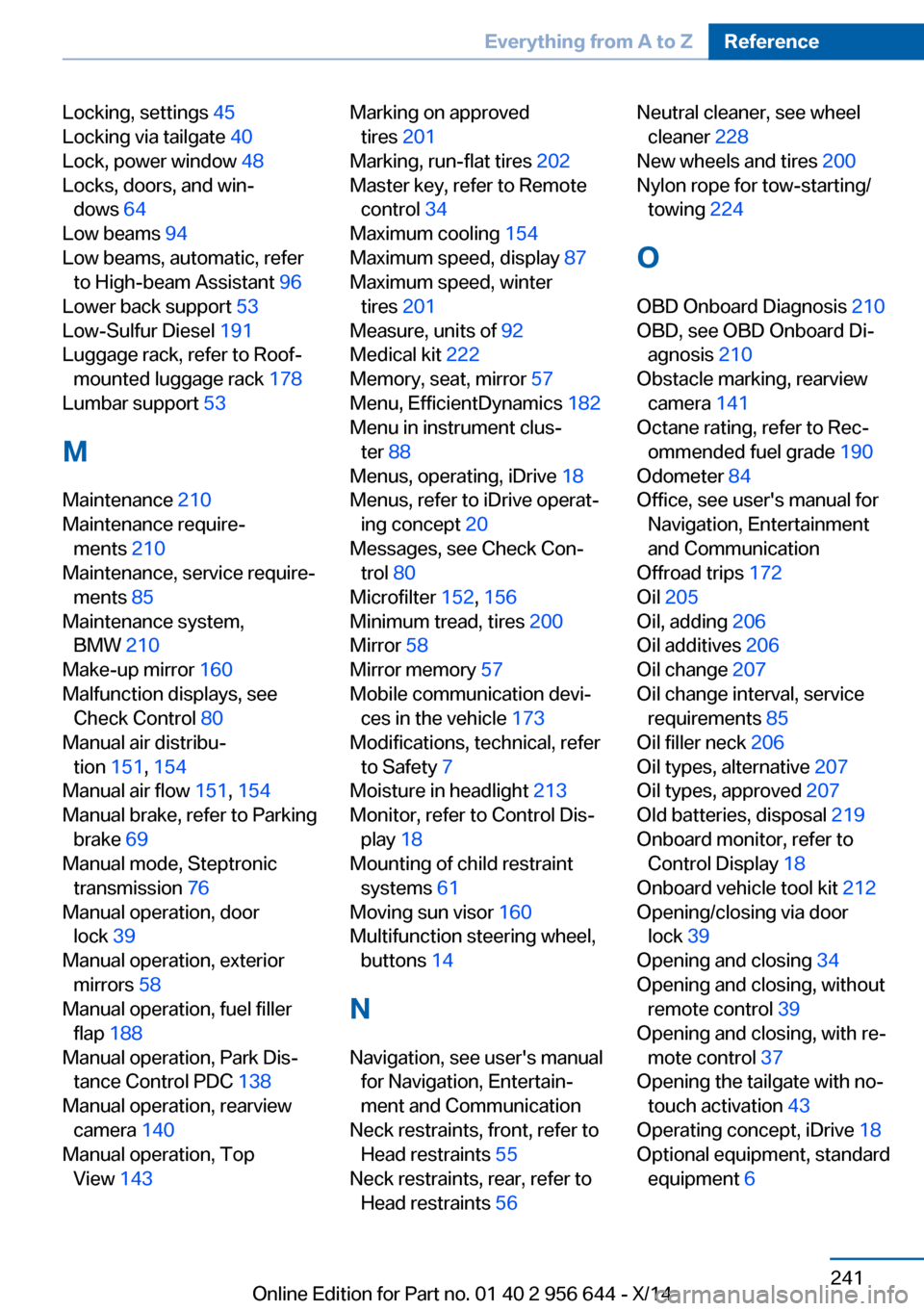
Locking, settings 45
Locking via tailgate 40
Lock, power window 48
Locks, doors, and win‐ dows 64
Low beams 94
Low beams, automatic, refer to High-beam Assistant 96
Lower back support 53
Low-Sulfur Diesel 191
Luggage rack, refer to Roof- mounted luggage rack 178
Lumbar support 53
M
Maintenance 210
Maintenance require‐ ments 210
Maintenance, service require‐ ments 85
Maintenance system, BMW 210
Make-up mirror 160
Malfunction displays, see Check Control 80
Manual air distribu‐ tion 151, 154
Manual air flow 151, 154
Manual brake, refer to Parking brake 69
Manual mode, Steptronic transmission 76
Manual operation, door lock 39
Manual operation, exterior mirrors 58
Manual operation, fuel filler flap 188
Manual operation, Park Dis‐ tance Control PDC 138
Manual operation, rearview camera 140
Manual operation, Top View 143 Marking on approved
tires 201
Marking, run-flat tires 202
Master key, refer to Remote control 34
Maximum cooling 154
Maximum speed, display 87
Maximum speed, winter tires 201
Measure, units of 92
Medical kit 222
Memory, seat, mirror 57
Menu, EfficientDynamics 182
Menu in instrument clus‐ ter 88
Menus, operating, iDrive 18
Menus, refer to iDrive operat‐ ing concept 20
Messages, see Check Con‐ trol 80
Microfilter 152, 156
Minimum tread, tires 200
Mirror 58
Mirror memory 57
Mobile communication devi‐ ces in the vehicle 173
Modifications, technical, refer to Safety 7
Moisture in headlight 213
Monitor, refer to Control Dis‐ play 18
Mounting of child restraint systems 61
Moving sun visor 160
Multifunction steering wheel, buttons 14
N
Navigation, see user's manual for Navigation, Entertain‐
ment and Communication
Neck restraints, front, refer to Head restraints 55
Neck restraints, rear, refer to Head restraints 56 Neutral cleaner, see wheel
cleaner 228
New wheels and tires 200
Nylon rope for tow-starting/ towing 224
O OBD Onboard Diagnosis 210
OBD, see OBD Onboard Di‐ agnosis 210
Obstacle marking, rearview camera 141
Octane rating, refer to Rec‐ ommended fuel grade 190
Odometer 84
Office, see user's manual for Navigation, Entertainment
and Communication
Offroad trips 172
Oil 205
Oil, adding 206
Oil additives 206
Oil change 207
Oil change interval, service requirements 85
Oil filler neck 206
Oil types, alternative 207
Oil types, approved 207
Old batteries, disposal 219
Onboard monitor, refer to Control Display 18
Onboard vehicle tool kit 212
Opening/closing via door lock 39
Opening and closing 34
Opening and closing, without remote control 39
Opening and closing, with re‐ mote control 37
Opening the tailgate with no- touch activation 43
Operating concept, iDrive 18
Optional equipment, standard equipment 6 Seite 241Everything from A to ZReference241
Online Edition for Part no. 01 40 2 956 644 - X/14